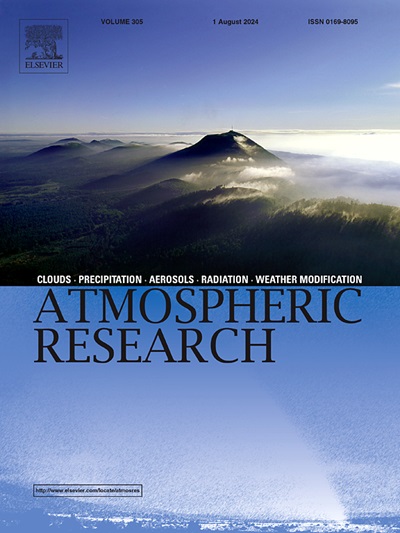Understanding the aerosol impact on the electrification of PyroCb thunderstorm
IF 4.5
2区 地球科学
Q1 METEOROLOGY & ATMOSPHERIC SCIENCES
引用次数: 0
Abstract
Understanding and predicting pyrocumulonimbus (pyroCb) thunderclouds is challenging due to their unpredictable nature and potential to exacerbate wildfires. This study employs a three-dimensional (3D) numerical model with a non-inductive electrification mechanism to explore how fire-produced aerosol concentrations influence the charge structure and lightning activity in pyroCb. Aerosol particle concentrations ranging from 100 to 20,000 cm−3 were considered to generate realistic thundercloud charge structures, with the cumulus cloud setup based on environmental conditions derived from an inverted-V sounding profile. The SP98 non-inductive electrification scheme models charge transfer in pyroCb, and the Poisson equation is solved to identify regions where lightning discharges are likely to initiate, though actual discharges are not simulated. For aerosol concentrations between 500 and 5000 cm−3, negative non-inductive charging dominates, while extreme aerosol cases (5000 cm−3) enhance positive charging at altitudes of 3–7 km. These findings suggest that non-inductive charge separation between ice crystals and graupel leads to realistic charge structures under pyroconvective conditions simulated in this study, reflecting moderate-to-high aerosol environments characteristic of wildfire-driven pyroCb events. As aerosol concentrations increase from 500 to 5000 cm−3, the charge structure evolves from a dipole to a tripole (at 1000 cm−3) and eventually to an inverted dipole, enabling intra-cloud (IC) and negative cloud-to-ground (-CG) lightning. At higher concentrations (10,000–20,000 cm−3), a multi-layer charge configuration emerges, favoring intense positive cloud-to-ground (+CG) strokes. Sensitivity analysis reveals that low-to-moderate aerosol levels with strong wind shear promote IC lightning, while high aerosol levels favor +CG flashes. These findings highlight the complex interactions driving pyroCb dynamics and the importance of integrated modelling to predict wildfire-induced thunderstorms.
求助全文
约1分钟内获得全文
求助全文
来源期刊

Atmospheric Research
地学-气象与大气科学
CiteScore
9.40
自引率
10.90%
发文量
460
审稿时长
47 days
期刊介绍:
The journal publishes scientific papers (research papers, review articles, letters and notes) dealing with the part of the atmosphere where meteorological events occur. Attention is given to all processes extending from the earth surface to the tropopause, but special emphasis continues to be devoted to the physics of clouds, mesoscale meteorology and air pollution, i.e. atmospheric aerosols; microphysical processes; cloud dynamics and thermodynamics; numerical simulation, climatology, climate change and weather modification.
 求助内容:
求助内容: 应助结果提醒方式:
应助结果提醒方式:


